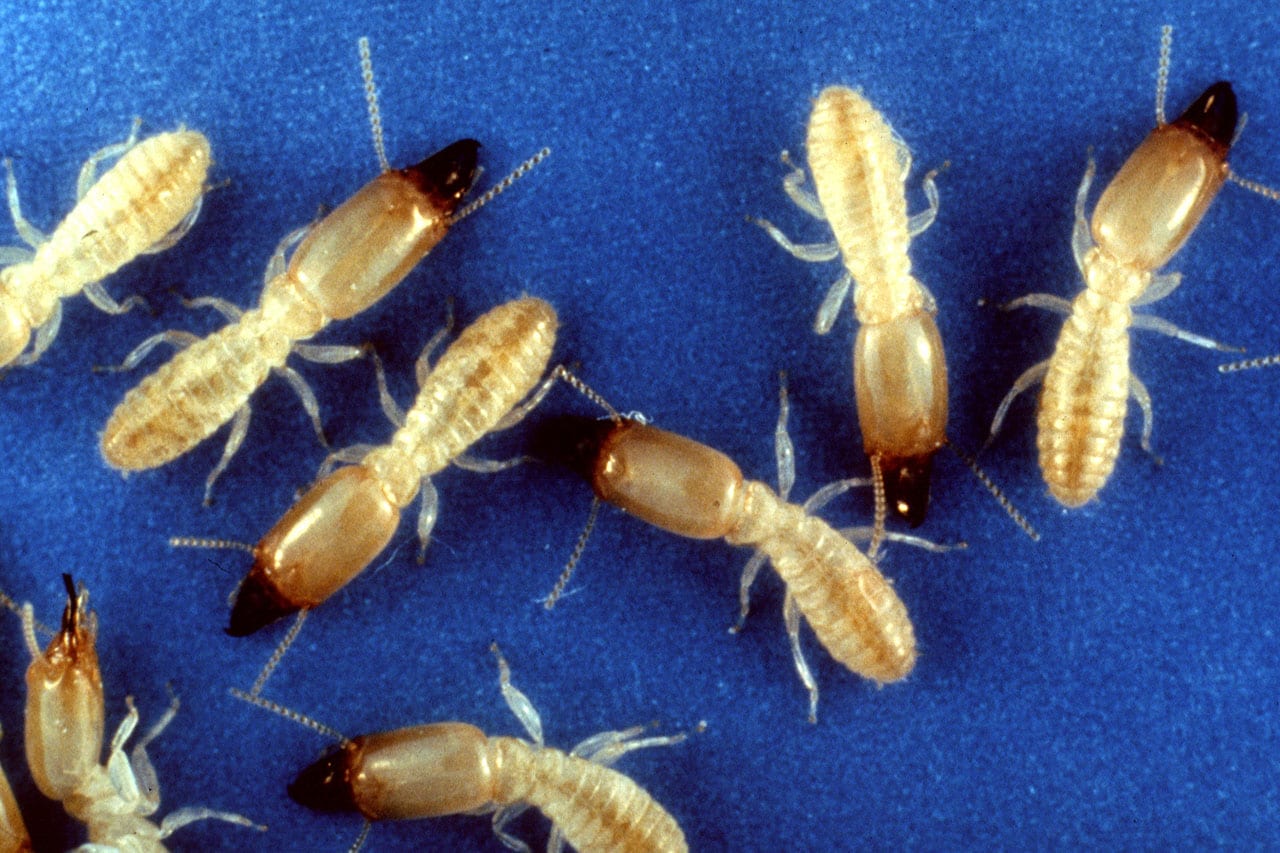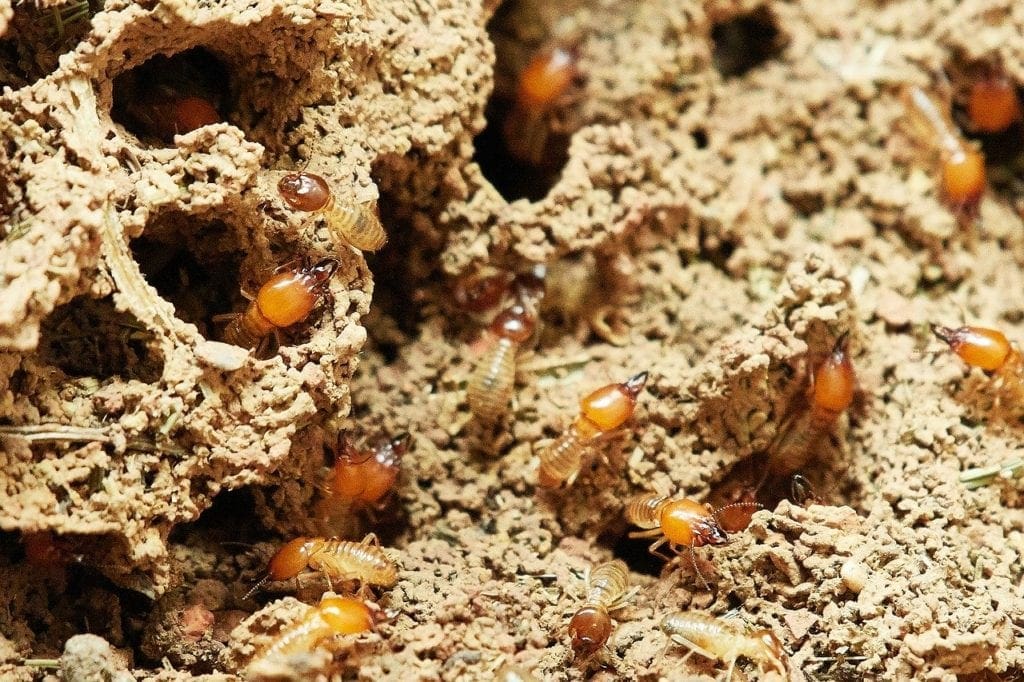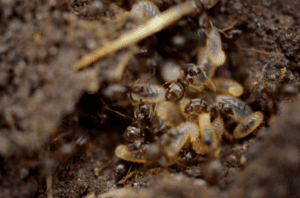
Understanding what causes termites is crucial for home and business owners looking to protect their properties. These destructive pests thrive in specific conditions, often leading to costly damage if left unchecked. In this article, we will explore the key facts about termites, including their preferred habitats, diet, and the environmental factors that contribute to infestations. By knowing what attracts termites, you can take proactive measures to safeguard your home from these wood-eating insects.
What Are Termites?
Termites look like small, soft-bodied insects that range in color from pale white to light brown. Commonly asked in searches like "what is termites?", these insects vary from ⅛ inch to 1 inch depending on their species and specific colony role. Termites are known for living in large, highly organized colonies; they have distinct roles, including workers, soldiers, and reproductive individuals. Workers have no wings and are responsible for building and maintaining the nest. Reproductive termites, called alates, have wings and are responsible for repopulating current colonies as well as founding new colonies. Soldiers are wingless, like workers, and they have specialized mandibles that they use to defend the colony.
Termites thrive in warm, moist environments and are commonly found in tropical and subtropical regions, though they exist in most parts of the world. They live in wooden structures, soil, or decaying plant material, depending on the species. Known for their ability to digest cellulose, termites feed primarily on wood, making them notorious pests for wooden structures. Their colonies can grow to millions, and they use intricate tunnels and chambers to transport food and protect their community.
Types of Termites
These soft-bodied insects and come in various species, each adapted to unique environments and diets. Among the main types of termites are:
Subterranean Termites
- Habitat: Prefer living underground or in moist, concealed environments; they build extensive mud tube systems to access food sources above ground.
- Diet: Primarily feed on wood, paper, and other cellulose-rich materials.
- Common Species: Eastern Subterranean Termite, Formosan Termite.
Drywood Termites
- Habitat: Thrive in dry wood, such as in furniture, structural timber, and dead trees; do not require contact with soil.
- Diet: Feed directly on dry wood, consuming cellulose from the inside out.
- Common Species: Western Drywood Termite, Southeastern Drywood Termite.
Dampwood Termites
- Habitat: Found in damp, decaying wood, often near water sources such as leaky pipes, tree stumps, or logs.
- Diet: Prefer moist, decayed wood, consuming cellulose and leaving smooth galleries.
- Common Species: Pacific Dampwood Termite, Florida Dampwood Termite.
Where Do Termites Come From?
Termites are most common in warm, humid regions, particularly in tropical and subtropical climates. However, they can be found almost anywhere, from tropical rainforests to temperate areas. In the United States, the Southeast is particularly susceptible, with states like Florida, Texas, and Louisiana facing severe termite infestations. Even in cooler areas like New Jersey, termites are a significant concern, especially subterranean termites.
In New Jersey, termites are particularly problematic in coastal areas, such as Cape May, Atlantic City, and the surrounding counties, where moisture levels are higher due to proximity to the ocean. Areas in Bergen County that are particularly susceptible to termite infestations include Teaneck, Hackensack, Paramus, Fort Lee, and Ridgewood. High-risk areas include regions with older, wood-frame homes and buildings, and regions near forests or wetlands, like the Pine Barrens. Properties in these areas are often more vulnerable due to environmental factors like high humidity, abundant wood sources, and moist soil conditions that attract termites.
Homes become more susceptible to termite infestations due to several factors. Poor drainage around the foundation, leaking pipes, or excessive landscaping moisture can provide the damp conditions termites prefer. Wood in direct contact with soil, such as wooden decks or fences, creates an easy entry point for termites. Termites are drawn to environments where moisture and wood are readily available, allowing them to thrive. Homeowners should be proactive in addressing potential risk factors to reduce their chances of a termite infestation.
What Causes Termites?
Termites are attracted to and infest certain homes for very specific reasons. Properties with the following qualities are at the highest risk for termite infestations:
- Moisture Problems: Termites are attracted to moisture, which is essential for their survival. Improper drainage around the home's foundation, leaking pipes, or standing water can create damp conditions that invite termites. Subterranean termites, in particular, rely on moisture-rich environments to build their colonies.
- Wood-to-Ground Contact: When wooden structures, such as decks, fences, or support beams, are in direct contact with the soil, they provide easy access for termites. Subterranean termites, which live underground, can tunnel directly into these wooden materials, making the home or business vulnerable to infestation.
- Cracks in the Foundation: Small cracks or gaps in the foundation or walls of a building can allow termites to enter undetected. Once inside, they can begin feeding on wooden structures, causing damage over time. Even tiny cracks can be sufficient for termites to infiltrate a home or business.
- Untreated or Decaying Wood: Properties with untreated or unprotected wood are more susceptible to termite infestations. Many termites are particularly attracted to old, decaying wood because it is easier to consume and digest. This makes older buildings, or properties with neglected wooden structures, prime targets.
- Excessive Landscaping Mulch: Thick layers of mulch around the foundation can trap moisture and create a favorable environment for termites. If mulch is placed too close to the foundation, termites can use it as a bridge to access homes and businesses.
- Leaky Roofs or Gutters: Leaking roofs or gutters can lead to water accumulation, soaking wooden structures and making them attractive to termites. The moist conditions can weaken the wood and create an ideal habitat for termites to infest.

How to Get Rid of Termites
To get rid of and to prevent termites, a combination of proactive maintenance and professional treatment is essential. Property owners should address moisture issues by fixing leaks, improving drainage, and ensuring that wood does not make direct contact with soil. Regularly inspecting the property for signs of termites, such as mud tubes or damaged wood, is also key. Preventative measures, like using termite-resistant building materials and applying chemical barriers around the foundation, can reduce the risk of infestation.
However, when termites are already present, professional termite control is the only reliable solution. Termite infestations are often extensive and difficult to detect, making DIY methods inadequate for complete eradication. Pest control professionals have the expertise, tools, and products needed to locate colonies, apply effective treatments, and prevent termites from returning. Advanced techniques, like baiting systems and soil treatments, are typically beyond the scope of non-professional approaches.
When choosing a termite control professional, it is important to select a licensed, experienced company with a solid reputation. Look for companies that offer thorough inspections, customized treatment plans, and guarantees on their work. Checking online reviews, asking for referrals, and confirming that the provider is certified in termite control can help ensure the right choice.
Understanding what causes termites is essential for effective prevention and control. With years of experience in both residential pest control and commercial pest control, Twin-Boro’s expert team is equipped to identify and eliminate termite infestations efficiently. Through our partnership with Sentricon, we utilize advanced techniques and treatments tailored to your specific needs, guaranteeing that your property remains protected. Don’t wait until it’s too late- contact us today to learn more about our expert termite removal services and safeguard your home or business from these destructive pests.






